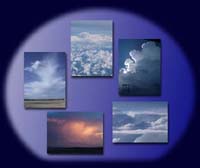Sun through Water and Ice Clouds
|
In RoundSun1.jpg, RoundSun2.jpg and Degas.jpg the sun looks like a circle, whereas it seems to be diffuse in DiffuseSun1.jpg and DiffuseSun2.jpg. The sun is also pictured somewhat blurred in SunCirrus1.jpg and SunCirrus2.jpg. Cirrus clouds consisting of aspheric, angular ice particles with
definite cristal structure generate the blurred border of the
sun. If a cloud consists of liquid, that means spherical water
droplets the sun can be recognized as a distinguished circle through
the cloud layer. Spherical droplets scatter the incident sunlight
preferentially in forward direction towards the observer. Ice
particles generate several reflections in different directions.
|
Also watching the sun from an aircraft it also seems to be blurred
when even higher Cirrus clouds occur (SunCirrus1+2.jpg taken at
an altitude of 10 km). The images have a structure in diagonal
direction because of scratches on the window pane of the aircraft.
Cirrostratus3.jpg, Cirrostratus4.jpg and Cirrostratus2.jpg (look
also to Cirrostratus)
were taken from the ground. Because of the ice particles in the
Cirrus clouds they show a diffuse sun. In chapter Objects
in clouds the characteristic sizes of droplets and ice particles
are summarized. |
RoundSun1.jpg, RoundSun2.jpg: S. Borrmann, Pulpit Rock, Carinthia,
Austria, 1 January 2003 at noon-time Cirrostratus2.jpg: R. Weigel, S. Borrmann, Forli, North Italy,
APE-Infra Field Campaign, October 2002 (see also chapter Cirrostratus)
Degas.jpg: Edgar Degas "Cheveaux de Course", Oil Painting,
107 cm x 73 cm (1869 - 1872), Barber Institute of Fine Arts, University
of Birmingham, United Kingdom |
|
Camera Parameters Except Cirrostratus2.jpg all pictures were taken with a SLR (14-54 mm objective), whereby zoom and dimming were changed from picture to picture. Exposure and selectivity choice (100 ASA) was performed by the program automation. Colour range (sRGB) and resolution (2560 x 1920 Pixel x 24 colours) was the same for all images. |
![]()















